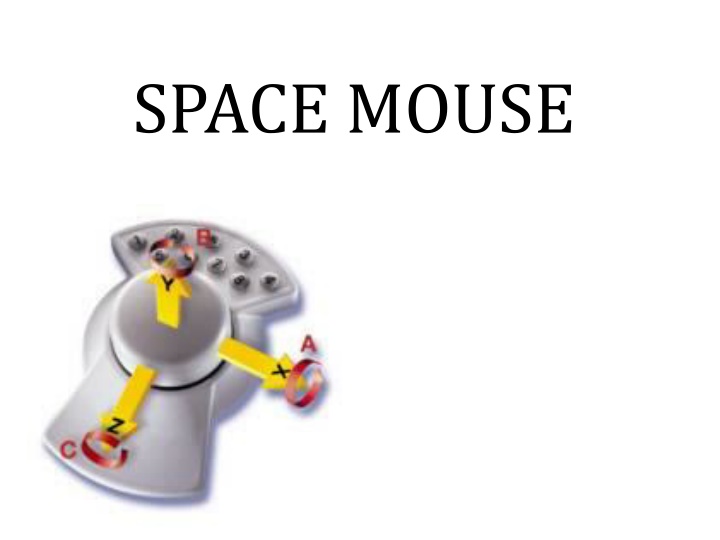Introduction to Space Mouse: A Revolutionary 3D Controller
Space Mouse, developed by the DLR Institute of Robotics and Mechatronics, is a professional 3D controller with unique mechatronics engineering principles. It offers intuitive manipulation of objects in 3D environments, including various modes of operation and precise motion control. With adjustable sensitivity, programmable buttons, and ergonomic design, Space Mouse provides groundbreaking interface capabilities for enhanced user experience.
Download Presentation

Please find below an Image/Link to download the presentation.
The content on the website is provided AS IS for your information and personal use only. It may not be sold, licensed, or shared on other websites without obtaining consent from the author.If you encounter any issues during the download, it is possible that the publisher has removed the file from their server.
You are allowed to download the files provided on this website for personal or commercial use, subject to the condition that they are used lawfully. All files are the property of their respective owners.
The content on the website is provided AS IS for your information and personal use only. It may not be sold, licensed, or shared on other websites without obtaining consent from the author.
E N D
Presentation Transcript
OUTLINE: Introduction Principle Space mouse Types Specifications Features Working Visual space mouse Applications Advantages Future scope Conclusion
Introduction: Space mouse is developed by the DLR institute of robotics and mechatronics. DLR- Raumfahrt. Deutsches Zenturum far Luft-und First prototype applications of DLR control was showed from 1982-1985. The high sales price of about $8,000 per unit
Principle: The basic principle behind its construction is mechatronics engineering and the multisensory concept. Measuring system is drift-free and not subject to aging effects. Movements were measured by electromagnetic or ultrasonic. The measuring arrangement in the inner ring is composed of the LED, a slit and perpendicular to the slit on the opposite side of the ring a linear PSD.
SPACE MOUSE: Space Mouse is a professional 3D controller manipulating objects in a 3D environment. It has different modes of operation in which it can also be used as a two-dimensional mouse. Groundbreaking interface. Enables the user to intuitively zoom, pan and rotate models.
TYPES: Two types of space mouse Space mouse classic Space mouse plus
Specifications: Space Mouse Classic Space Mouse Plus PRODUCT SENSITIVITY adjustable adjustable BUTTONS 9, programmable 11, plus Quick tip programmable INTERFACE RS-232C RS-232C or USB CONNECTOR D-sub 9 pin D-sub 9 pin or USB WEIGHT Weight 1.46 lb (0.66 kg) 1.5 lb (0.68 kg) DIMENSIONS (LxWxH) 6.50" x 4.41" x 1.57" 7.40" x 4.72" x 1.73" (188 x 120 x 44mm) (165 x 112 x 40mm) WARRANTY 36 Months 36 Months
Features: Ease of use of manipulating objects in 3D applications. Calibration free sensor technology for high precision and unique reliability. Nine programmable buttons to customize users preference for motion control. Fingertip operation for maximum precision and performance. Adjust sensitivity and motion control to the users preference. Small form factor frees up the desk space. Natural hand position (resting on table) eliminates fatigue.
Working: Inside a mouse: Figure :1
The exposed portion of the ball touches the desktop Figure :2
Rollers detection: Figure :3
A typical optical encoding disk: Figure :4
A close-up of one of the optical encoders that track mouse motion Figure :5
The logic section of a mouse Figure :6
Visual space mouse: Visual space mouse can be divided into two main parts Robot control Image processing
Applications: Works in graphical applications. Object manipulation in 3D applications.
Advantages: Drawing times is reduced by 20%-30% . Works without an additional power supply. Adapted for a wide range of tasks including mechanical design, real time video animation and visual simulation.
Future scope: ROTEX is the only well known virtual environment. Machine instruction allowance. To develop virtual environment using space mouse.
Conclusion: we believe there is no other man- machine interface technology comparable to Magellan in its simplicity and yet high precision. It is used for 3D manipulations in 6 doff, but at the same time may function as a conventional 2D mouse.


![Read⚡ebook✔[PDF] Linking the Space Shuttle and Space Stations: Early Docking Te](/thumb/21519/read-ebook-pdf-linking-the-space-shuttle-and-space-stations-early-docking-te.jpg)
![READ⚡[PDF]✔ Emerging Space Powers: The New Space Programs of Asia, the Middle Ea](/thumb/21554/read-pdf-emerging-space-powers-the-new-space-programs-of-asia-the-middle-ea.jpg)

















